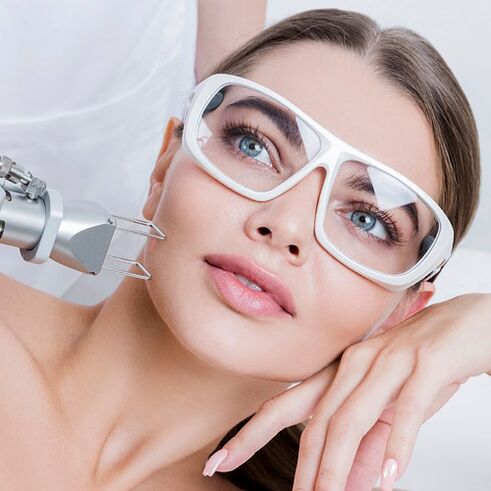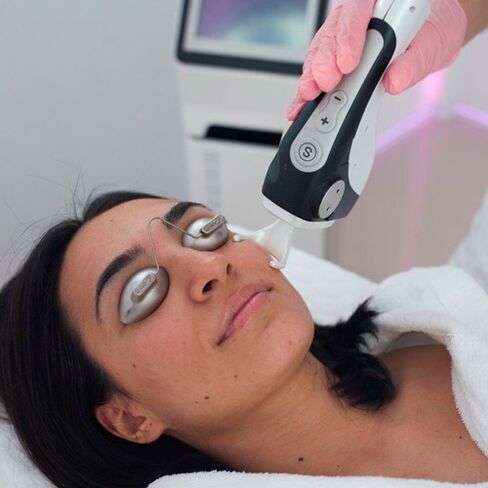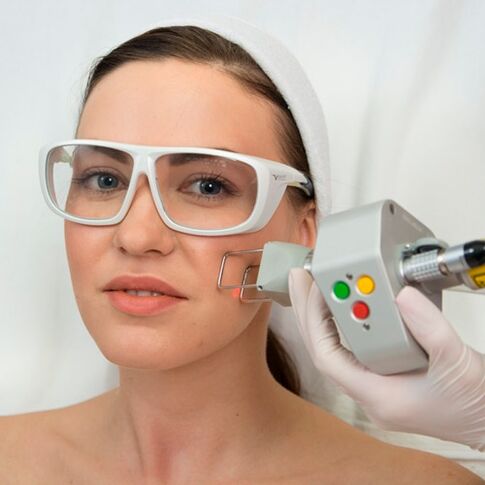Fractional Laser Skin Rejuvenation-A cosmetic procedure during which the skin is exposed to a laser array made of microbeams. The purpose of this effect is to activate the regeneration process and collagen production. This is a relatively new but already very popular hardware technology. In other words, it is called fraxel, fractional laser skin resurfacing, or photothermal decomposition.

Operating principle and types of fractional laser skin rejuvenation
How does a lattice laser work? The micro-rays emitted by the instrument can cause heat shock, and the "lazy" skin cells begin to play a more active role. In order to repair the damaged area, they split faster. It turned out that invalid old cells died and gave way to younger cells. The deep heating of the skin is accompanied by partial denaturation of proteins and the formation of new components of the extracellular matrix, including elastin and collagen.
Distinguish the depth of influenceAblative and non-ablation laser skin rejuvenation. . . The first one is superficial, similar to grinding. Laser treatment of the upper layer of the skin is accompanied by the evaporation of water, which damages the epidermis. After healing, the skin becomes more toned and its relief and color become even. In the non-ablation photothermal decomposition process, the laser acts on the deep layers of the skin. In this case, no open wound will be formed.
Each type of rejuvenation has its advantages and minutes. Therefore, after the first operation, the effect of ablative laser skin resurfacing is obvious. Using this method, you can remove deep wrinkles and age spots, post-acne, stretch marks, and scars. With non-ablation surgery, there is no risk of infection, and the anti-aging effect lasts for several years. This type of photopyrolysis is recommended for people under the age of 40. These people have the first signs of aging: fine lines and reduced swelling.

Indications and contraindications for surgery
If you have the following conditions, it is worth using the photothermal decomposition procedure:
- The skin is sagging and sagging.
- Fine and deep wrinkles, crow's feet.
- Pigmentation of any origin.
- Increased sebum secretion.
- Large pores, easy to get acne.
- Scars, stretch marks, post-acne.
- The vascular "asterisk" (rosacea).
- The complexion is dull.

The contraindications of fractional laser skin rejuvenation are:
- Allergies, psoriasis.
- Autoimmune diseases.
- Pregnancy, breastfeeding.
- Blood disease.
- Skin infection, inflammation of the area expected to be treated.
- Any chronic disease in the decompensation phase.
- Oncology.
- Increased body temperature.
- diabetes.
- There is a tendency to form keloids.
- epilepsy.

Features of laser skin rejuvenation
Part of the preparations for the photothermal decomposition program included denying access to the solarium and beach for two weeks. For a long time, you have not been able to clean your skin, do chemical peels, and take sulfa, fluoroquinolones, and tetracyclines. Three days before the operation, they stopped going to the swimming pool, bathroom, sauna, and treated the suspected exposed area with alcohol-based cosmetics. In order to prevent complications, beauticians can prescribe antiviral and antibacterial drugs during this period. Do not drink or smoke the day before the operation, and do not go to the gym.
Before laser treatment, clean the cosmetics and impurities on the skin. Generally speaking, the effect of the laser is an unpleasant tingling sensation, but sometimes it may be necessary to relieve the pain. In this case, the beautician applies anesthetic to the prepared skin area. After the ointment worked, he continued to treat the skin with the laser. The duration of the operation depends on the scope of the treatment area, ranging from a few minutes to an hour. Finally, use a nourishing cream to soothe the skin.
On the first day after surgery, you cannot use alcohol-based products to compress body parts that undergo photothermal decomposition with compressed linen. It is recommended to exclude physical activity within a week, go to the swimming pool, sauna or bath, and limit the time spent on the street. Moisturize the skin with a special cream three times a day. It was like this for half a month. It is not suitable for skin resurfacing. Use cosmetics containing retinol and salicylic acid. A face cream with a sun protection factor of 35 or higher must be used within two months.

How many processes are needed to achieve the effect? What can you expect?
The recovery period after laser fractional rejuvenation is 3 to 7 days. The speed of recovery depends largely on lifestyle. Drinking, smoking, excessive activity, unbalanced diet, insomnia and anxiety-all of these slow down the regeneration process.
In the first three days after laser irradiation, redness and slight swelling of the skin may be observed. Anesthetics and cooling the skin help reduce discomfort. If you feel skin tightness and flaky areas within a week, this is normal. The side effect of this procedure may be bronzer, which will disappear on its own after half a month.
After 2-5 times of the procedure, the lasting result after fractional photothermal decomposition will occur. More specifically, the number of treatments can only be determined by the beautician based on the initial data. The interval between procedures is 3-4 weeks. As a result of fractional laser skin rejuvenation, the aging process is inhibited: wrinkles disappear or become less noticeable, swelling increases, pore severity decreases, and skin tone improves. This method is an effective tool to combat scars, pigmentation, post-acne, and stretch marks.
Fractional laser skin rejuvenation is one of the three most popular hardware cosmetic procedures. Its advantages include efficiency, short healing period, and physiology. The results are visible after the first surgery and can last up to three years. This method has a wide range of indications. The depth of laser exposure can be selected.
























